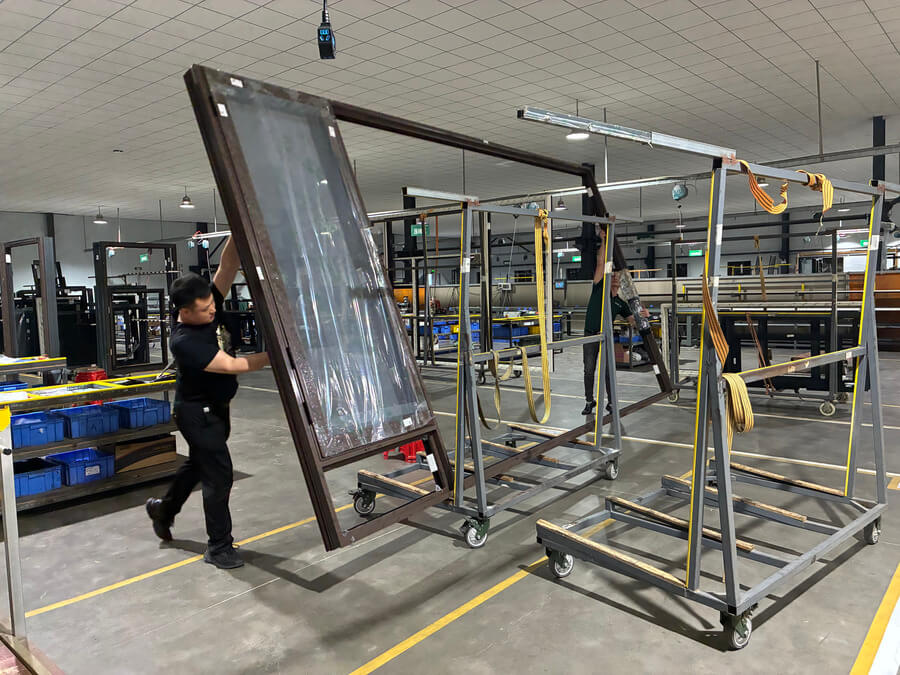What Exactly Does “Standard Door Size” Mean?


Before attempting to take any measurements, it is necessary first to define the term “standard door size.” It is among the most common misconceptions in this industry.
A door slab is the door itself. It is a single solid piece without hinges, a frame, or any associated hardware. The door frame is the surrounding framework that contains the door, on the other hand. Lastly, the rough opening is the framed hole in the wall where you would install the door unit. All three measurements of a standard door are different, and all are important.
“Standard” would typically mean the most readily available sizes and most generally accepted in a particular place or application. Yet, building codes, architectural style, and different national systems of measurement make such “standard door sizes” differ greatly around the globe. For instance, a standard US interior door would not be suitable for an entrance door to a house constructed in the UK.
Standard Door Sizes by Type
Let’s break down door sizes based on type and function.
A. Exterior Entry Doors

Exterior doors are the entrance point for guests and are essential both for residential security and better insulation. In the U.S. and Canada, a standard exterior door measures 36 inches in width and 80 inches in height (3’0″ x 6’8″). The dimensions provide ample mobility of furniture and appliances and also satisfy accessibility requirements.
Other common sizes include:
- 32″ x 80″ (often for back doors or secondary entrances)
- 30″ x 80″ (older homes or narrow entrances)
- 36″ x 96″ (taller homes with high ceilings)
Standard door thickness is typically 1¾ inches for exterior doors.
In the UK and Europe, you’ll find metric sizing like:
- 1981 x 838 mm
- 2040 x 926 mm
European doors also tend to have different frame construction methods, which affect final measurements.
In Asia and Australia, standard exterior doors often align with imported European or American sizes, though regional practices and climate considerations may lead to slight variations. Common standard door sizes include:
- 900mm × 2100mm (approximately 36” × 83”): A popular exterior door size in modern homes
- 820mm × 2040mm (approx. 32″ × 80″): Usually applied to inner or comparatively narrower outer doors
- Bespoke oversized doors (up to 1200mm wide or 2400mm tall) are also popular in modern design, particularly for entrance doors to be utilized for impact effect
B. Interior Doors

Interior room doors do not have to be as thick or heavy as front doors, but size is still required for comfort and in compliance with code. Standard heights typically range from:
- 78 inches (older homes in the UK)
- 80 inches (most modern builds worldwide)
- 84 or 96 inches (custom or luxury homes)
Standard door widths include:
- 24 inches (closets)
- 28 inches (small bedrooms or utility rooms)
- 30 – 32 inches (general passage doors)
- 36 inches (wheelchair-accessible)
In metric:
- 1981 x 762 mm
- 2040 x 826 mm
Door thickness for interiors is usually 1 ⅜ inches.
C. Sliding Doors and Bifold Doors

For sliding glass doors or closet bifolds:
- Common sliding patio doors: 72″ x 80″ (two-panel), 96″ x 80″ (three-panel)
- Bifold closet doors: 24″–36″ panels, combined for larger openings
When measuring these, track systems and overlap are essential considerations.
D. Commercial Door Sizes
Commercial doors are typically wider and taller than residential ones. Standard sizes include:
- 36” x 84” or 36” x 96”
- Fire exits and ADA-compliant entries may be 42” wide
Modular widths for industrial applications can also be provided in steel or aluminum doors. The local building codes must always be referred to.
| Door Category | Standard Door Width (Inches) | Standard Door Height (Inches) | Standard Door Thickness (Inches) |
| Interior Passage Doors | 26″ – 36″ | 80″ | 1 3/8″ |
| Exterior Entry Doors | 36″ | 80″ | 1 3/4″ |
| Bedroom/Bathroom Doors | 28″ – 34″ | 80″ | 1 3/8″ |
| Sliding Patio Doors | 60″ – 96″ (total panel width) | 80″ | 1 1/2″ – 2 1/4″ |
| French Doors | 60″ (two 30″ panels) | 80″ | 1 3/4″ |
| Garage Doors | 96″ – 192″ (8–16 ft) | 84″ – 108″ (7–9 ft) | Varies: ~1 3/4″ – 2 1/4″ |
| Closet Doors (Bifold/Slider) | 24″ – 36″ | 80″ – 96″ | 1 3/8″ |
| Industrial/Commercial Doors | 36″ – 42″ | 80″ – 84″ | 1 3/4″ |
How To Measure a Door Accurately
Taking door measurements shouldn’t be hard. However, you have to try your best to be as accurate as possible. Minor mistakes can cause expensive delays or an improper fit. You don’t want to be having a bedroom and office door instead of an exterior door. Some tools that you’ll require include:
- Tape measure
- Carpenter’s level
- Pencil and notepad
- Laser level for large openings (optional)
Step-by-Step Guide to Measuring Door Dimensions Correctly
Below is a step-by-step expert guide to ensure your door measurements are precise and reliable.
1. Measure Your Door Width
Measure the door opening in three places (bottom, middle, and top). Walls do shift and change direction over time, and each section will be slightly different. Measure the three places using a tape measure, note all three, then base it on the smallest of these. That way, the new door will fit even if the opening is not square, with a little extra space to adjust or shim when installed.
2. Measure the Door Height
Measure from a finished floor (not subfloor or rough concrete) to the bottom of the top door frame or head jamb. Take care not to simply measure the slab present, as it might not be the whole opening. Flooring materials such as tile or carpeting will influence this measurement as well. Always verify that you are measuring from finished surfaces.
3. Measure the Thickness
There are two parts to this: the door slab itself and the wall depth if you’re replacing a prehung door. The majority of standard interior doors are 35mm–45mm (1⅜” to 1¾”) thick, while exterior doors tend to be thicker for strength and insulation. Wall depth becomes a factor in selecting a frame and door jamb that will be flush with the wall surrounding it.
4. Account for the Rough Opening
The rough opening is a bit bigger than the door slab to fit the frame, shims, and small adjustments. A good rule of thumb for a typical door is to take your door slab width and height and add approximately 2 inches to each. So, for instance, a 36″ × 80″ door would most likely need a rough opening of 38″ × 82″. Always refer to the manufacturer’s instructions since some custom doors might need a bit more clearance.
5. Determine the Swing Direction
You need to have the direction of the door swing, especially for hinged doors. Face the door on the swinging side. Hinges on the right, it’s a right-hand door; hinges on the left, it’s a left-hand door. Note also if it swings in or out. This will impact hardware placement and building code conformity. This prevents the incorrect type of prehung or slab door from being ordered.
Pro Tips for Measuring Doors Accurately
Even pros take special care when measuring doors because a slight mistake can result in the wrong size being ordered or in costly rework. These pro tips can help you make all the difference:
- Always double-check door measurements.
- See if the floors are level (particularly in old buildings).
- Be aware of wall trim or baseboards that may obstruct.
- Write down all dimensions clearly before ordering or cutting.
- Confirm whether the measurement is for a slab or prehung door.
- Account for door hardware and clearance gaps.
Factors Influencing the Selection of Door Size


Selecting door size correctly is not simply a case of selecting what appears right. There’s a mix of functional requirements, accessibility considerations, room traffic flow, and structural factors. Listed below is an analysis of the significant issues that determine that your ideal door size will fit perfectly:
Purpose
The function of the door is a major driver of its size. Entrance doors are wider and taller than interior doors to allow easy movement for individuals, furniture, or devices. Unlike bathroom doors, closet doors, or feature doors which may be narrower since they are used less often or by small entities.
Building Codes
Local regulations often dictate minimum door widths and clearance requirements. These laws include fire safety standards and accessibility laws like the Americans with Disabilities Act (ADA). For example, ADA-compliant doors must be at least 32 inches wide when open to allow wheelchair access. Compliance should always be checked during design.
Room Size
The door dimensions must be proportional to the hallway or room that it opens into. The average door size of a grand entrance door will be different from bathroom doors or other interior rooms. Likewise, the standard size for residential homes will differ from commercial buildings. A 36-inch door on a narrow hallway can be overwhelming and infringe on space. In small rooms, smaller doors (28 – 30 inches) are generally a more visually appealing compromise for form vs. function.
Door Swing
Door direction and radius are significant. In-swinging large doors can interfere with walls, fixtures, or furniture, minimizing layout possibilities. Out-swinging or sliding doors in small rooms save space and improve circulation.
Material
More dense materials like metal, solid oak, or reinforced glass can impact door size because of weight. Larger and taller doors constructed of such materials may need reinforced hinges, heavier frames, or special installation hardware. In others, there are size limits to avoid warping or sagging.
Installation Method
Whether you’re installing a slab door or a prehung unit makes a difference in the required space. Prehung doors include a frame and often need a slightly larger rough opening. Slab doors, which are just the panel, may fit tighter spaces but require more precise alignment during installation.
Mistakes to Avoid in Measuring Door Size or Choosing Doors
Even DIYers and professional contractors get measuring wrong sometimes. This will often result in delays, extra expense, or poor fit. Here are the most common mistakes you want to avoid when replacing your existing door or installing a new one:
- Measuring just the slab, not the opening: The most frequent error individuals make is that they measure just the door slab (panel) and not the frame or the rough opening. This leads to a door that does not fit or one that cannot accommodate hardware and shimming space.
- Not considering door swing direction: A door’s swing direction, in or out, left or right, will influence clearance, furniture, and traffic. An incorrect swing direction can obstruct routes or interfere with adjacent walls or fittings.
- Not taking flooring changes into account (i.e., adding tile or carpet): New flooring added after measuring (like thick carpet or tile) reduces vertical clearance. This most often causes doors to drag or need to be trimmed after installation.
- Assuming frames are always plumb and square, Walls and frames, particularly in older structures, are sometimes absolutely level. Not checking this will lead to gaps, sealing problems, or a binding or opening door.
- Ordering ahead of final framing completion: Ordering before the wall framing or finish flooring is done is risky. Small construction dimensional changes will ruin your fit, requiring costly rework or returns.
Conclusion

Measuring door dimensions correctly involves a mix of function, accuracy of measuring, and understanding how it affects the fit. The right information and guidance will help you avoid mistakes and achieve the look and function you desire. We have provided the information you need in this ultimate guide.
However, nothing beats professional input, and that’s what we offer at Boswindor. We will collaborate with you to get the best door options for your space. From sliding glass doors to patio doors, our experts will ensure you get flexible solutions that meet your style, color scheme, and functional needs. We also design custom doors for various needs. Contact us today to discuss further.
FAQs
What is the standard size of a house door?
Typical exterior doors on most U.S. homes are 36 inches wide and 80 inches tall. Standard interior door sizes are most commonly 30 to 32 inches wide, with the same 80 inches tall. These provide spacious passage under normal traffic and are generally standard for pre-made frames and hardware.
Are there standard sizes for double doors?
Yes. Most doors have standard door widths of double doors are 60 inches or 72 inches (overall width) with a standard door height of 80 inches. Double doors are typically installed on main entries, patios, or formal areas needing wider clearance and visual symmetry.
How wide should a door be for wheelchair access?
Such a door must have at least a 32-inch clear width when the door is open. That allows most standard wheelchairs to pass through easily. That generally requires a door that is at least 36 inches wide since hinges and door thickness reduce the space. A wider door is better to make it even more convenient to use in residential units, public buildings, or healthcare facilities.
















